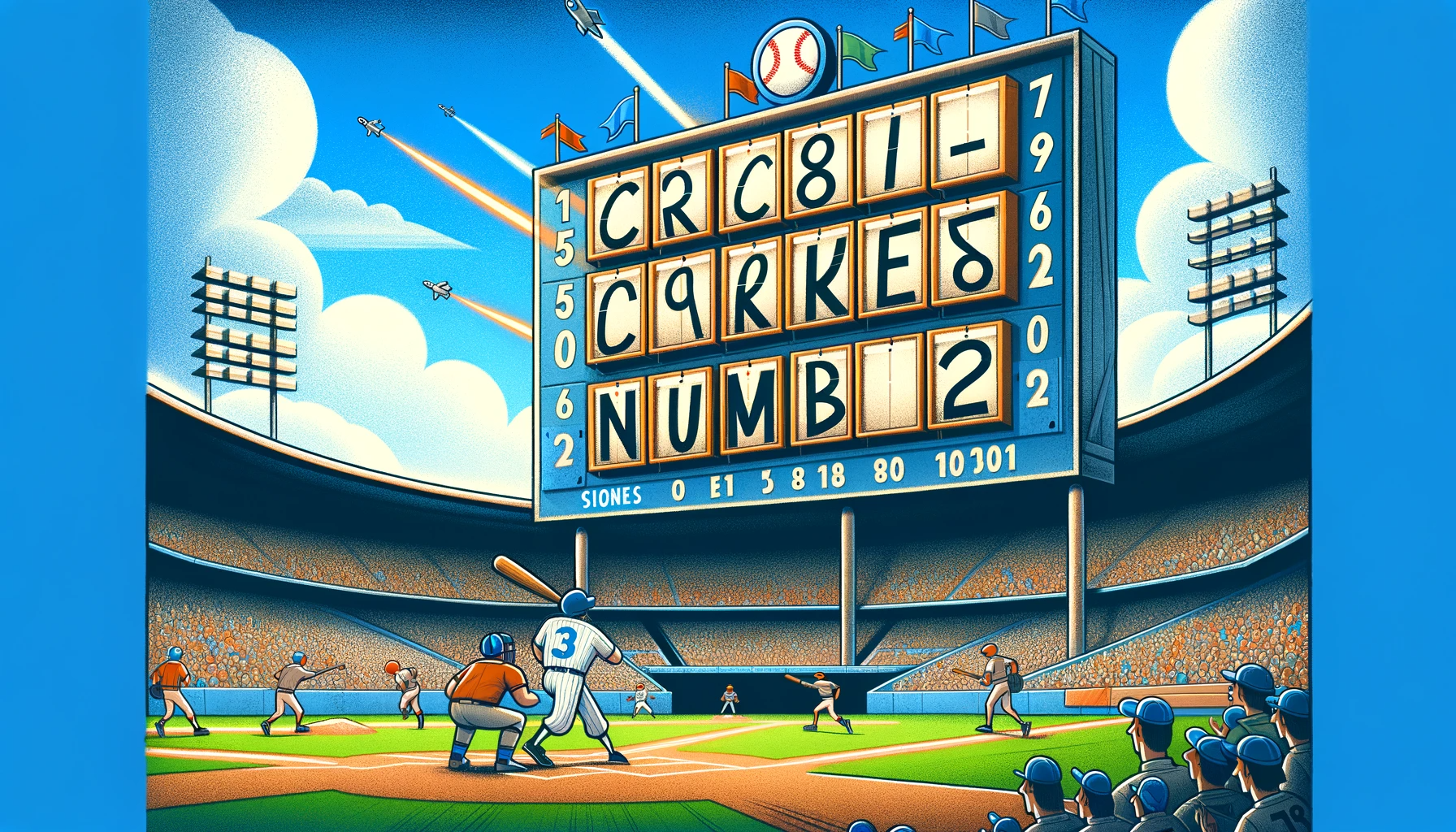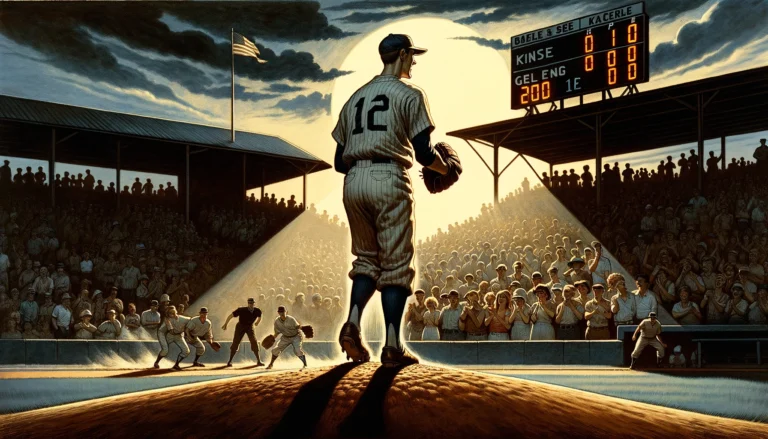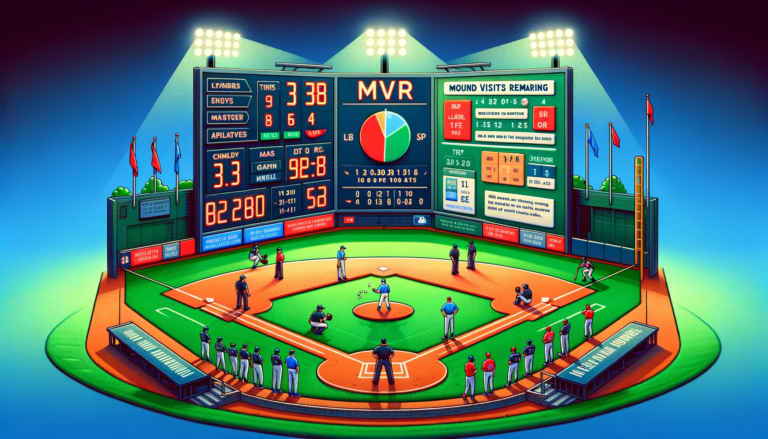What is a Crooked Number in Baseball?
A crooked number refers to when one team scores a bunch of runs in a single inning. The number on the scoreboard is “crooked” because it doesn’t contain just a single digit.
For example, if a team scores 5 runs in the third inning, that’s considered a crooked number inning. Or if they somehow manage to score 10 runs, that’s an even more crooked number!
Key Takeaways
- The term ‘crooked number’ refers to any inning in which a team scores more than one run, creating a non-linear digit on the scoreboard.
- Understanding crooked numbers involves grasping the basics of baseball scoring and recognizing their contrast with innings where teams ‘put up a zero’.
- Crooked numbers can lead to significant momentum shifts, affecting team morale and the psychological state of players on the field.
- Baseball history is peppered with famous instances where crooked numbers have led to dramatic comebacks and unforgettable upsets.
- The concept of crooked numbers extends beyond the field, permeating baseball slang, commentary, pop culture, and is an essential part of educating new fans and players.
The Origin of ‘Crooked Number’

Historical Context of Baseball Jargon
Baseball, with its rich history stretching back to the 19th century, has developed its own unique language.
This linguistic tapestry includes a variety of terms that encapsulate the game’s strategy, culture, and humor. Among these is the term ‘crooked number’, a phrase that has stood the test of time.
The evolution of baseball jargon is a reflection of the game’s growth and the diverse influences that have shaped it.
Key to understanding this evolution is recognizing the role of:
- Players and their on-field chatter
- Commentators and their colorful play-by-play descriptions
- Fans and their adoption of baseball vernacular into everyday language
Each group has contributed to the lexicon, making baseball not just a sport, but a repository of anecdotes and expressions.
The term ‘crooked number’ is one such expression that has been passed down through generations, finding its place in the glossary of baseball terms.
How ‘Crooked Number’ Entered Baseball Vernacular
The term ‘crooked number’ found its way into baseball vernacular through a natural evolution of language within the sport.
It’s believed to have originated from the visual contrast between the digits themselves: straight-lined ‘1’s and ‘0’s, and the more complex shapes of numbers like ‘2’, ‘3’, or ‘8’.
- Players and commentators started using the term to describe innings where teams scored more than a single run.
- The phrase caught on because it succinctly captured the idea of a significant, game-changing inning.
- Over time, ‘crooked number’ became shorthand for a successful offensive inning in baseball circles.
As the sport grew in popularity, so did the lexicon associated with it, with ‘crooked number’ becoming a staple in the baseball community.
Read Also: What Does R Mean in Baseball
Decoding the Scoreboard: Understanding Crooked Numbers

The Basics of Baseball Scoring
In baseball, scoring is the ultimate indicator of a team’s success in a game. Each run scored represents a point, and the team with the most points at the end of nine innings wins the game.
The process of scoring involves a player advancing around the bases and safely reaching home plate.
The fundamental elements of baseball scoring include:
- Hits: When a batter successfully reaches at least first base.
- Walks: When a batter advances to first base due to four balls pitched outside the strike zone.
- Home Runs: When a batter hits the ball out of play in fair territory, allowing them to circle all bases and score.
Understanding these basics is essential for interpreting the scoreboard and recognizing when a team has put up a ‘crooked number’—a term used to describe multiple runs scored in a single inning, as opposed to a single run or none at all.
Identifying Crooked Numbers in a Game
In the context of baseball, a crooked number refers to any number greater than one that is posted by a team in an inning.
Here’s how to spot them during a game:
- Look at the scoreboard after each inning. If a team scores multiple runs, you’ll see numbers like 2, 3, 4, or higher—these are your crooked numbers.
- Contrast these with innings where a team fails to score or only manages a single run; these are represented by zeros or the number one, respectively.
Identifying crooked numbers is crucial as they often indicate a significant event in the game, such as a rally or a breakout performance by the offense.
For instance, a pair of crooked numbers in consecutive innings can signal a team’s dominance, while a single crooked number might suggest a momentary advantage.
Recognizing these patterns can enhance your understanding of the game’s flow and the strategies employed by each team.
Contrasting Crooked Numbers with ‘Putting up a Zero’
In the realm of baseball, scoring dynamics can pivot a game’s outcome dramatically. A crooked number signifies an inning where a team scores multiple runs, showcasing offensive strength and often changing the game’s momentum.
This is in stark contrast to ‘putting up a zero’, which indicates an inning where a team fails to score at all, reflecting either a strong defensive performance by the opposition or missed opportunities at bat.
- A crooked number can be any digit from 2 to 9, representing the runs scored in an inning.
- ‘Putting up a zero’ is represented by a lone digit, 0, on the scoreboard, and is often referred to as a ‘goose egg’.
The psychological impact of these scoring outcomes cannot be overstated. While crooked numbers can boost a team’s confidence and intimidate opponents, consecutive zeros may lead to mounting pressure and a sense of urgency for the batting team.
Understanding this dichotomy is crucial for fans and players alike, as it underscores the strategic ebb and flow inherent in baseball.
Read Also: What is MVR in Baseball
Strategic Implications of Crooked Numbers

Momentum Shifts and Team Morale
In the dynamic environment of a baseball game, crooked numbers can significantly alter the momentum of play.
When a team racks up multiple runs in an inning, it not only adds to the scoreboard but also injects energy and confidence into the team’s dynamic.
This surge can lead to a domino effect, where the players’ heightened morale translates into more aggressive base running, sharper defensive plays, and a more focused approach at the plate.
Conversely, when a team concedes a crooked number, the impact can be demoralizing. The sudden shift in the game’s pace can cause players to lose their rhythm and doubt their strategy.
The following points illustrate the effects of crooked numbers on team morale:
- A boost in team spirit and a sense of collective achievement.
- Increased pressure on the opposing team to respond in kind.
- Potential changes in managerial tactics, such as pitching changes or strategic substitutions.
The Psychological Effect on Pitchers and Batters
The mental game in baseball is just as crucial as the physical one, and crooked numbers can have a profound psychological impact on both pitchers and batters.
For pitchers, the pressure mounts as runs accumulate, often leading to a loss of focus and control.
This can result in a vicious cycle where anxiety begets more mistakes, and more mistakes lead to more runs.
Batters, on the other hand, may experience a boost in confidence when their team puts up a crooked number. This surge of morale can lead to more aggressive and successful at-bats.
However, it’s not always positive; batters facing a deficit may feel the weight of expectation to even the score, which can lead to overzealous swings and missed opportunities.
- The pitcher’s mindset can shift from attack to defense, altering their approach to the mound.
- Batters may adjust their strategy, either riding the wave of momentum or pressing too hard to make up ground.
- Team dynamics can change, with players either rallying together or showing signs of frustration and defeat.
How Teams Capitalize on Crooked Numbers
In the competitive world of baseball, capitalizing on crooked numbers can be a game-changer for teams.
A substantial inning can shift the momentum, providing a psychological edge and demoralizing the opposition.
Teams often use this surge to further their advantage in several ways:
- Applying Pressure: A big inning puts immediate pressure on the opposing team, forcing them to respond. This can lead to mistakes or overly aggressive plays.
- Strategic Substitutions: Managers might make pitching changes or strategic substitutions to maintain the lead and keep the opposing team off balance.
- Conserving Resources: With a comfortable lead, teams can rest key pitchers and players, saving them for future games.
Capitalizing on crooked numbers isn’t just about the immediate gain in runs; it’s about using that advantage to strategically position the team for the remainder of the game and beyond.
It’s a blend of tactical decisions and psychological warfare that can define the outcome of a game.
Read Also: What Does DFA Mean in Baseball
Famous Instances of Crooked Numbers in Baseball History

Memorable Games with High Scoring Innings
Baseball history is peppered with games that turned on the axis of a single, high-scoring inning. One such game that stands out is when King’s stellar effort was spoiled by the Brewers’ 8th-inning run.
Despite a strong performance, King was charged with a run when Turang crossed the plate, a pivotal moment that shifted the game’s momentum.
In these instances, a crooked number can redefine the narrative of a game:
- It can be the result of a strategic hit, like Perkins’ single that brought Turang home.
- A pitcher’s record, such as Wandy Peralta’s, can be blemished despite a season of dominance against specific hitters.
These high-scoring innings become etched in the memories of fans and players alike, often discussed and dissected long after the final out.
Record-Breaking Crooked Numbers
Throughout baseball history, certain innings have become legendary for their record-breaking crooked numbers.
The Texas Rangers set a remarkable record on August 22, 2007, when they scored 30 runs against the Baltimore Orioles, the most by a team in a single game since 1897.
Some other notable instances include:
- The Chicago White Sox scoring 11 runs in the 7th inning against the Seattle Mariners on April 23, 1955.
- The Cleveland Indians’ 14-run inning against the Boston Red Sox on June 18, 1950, which stands as a testament to their offensive prowess.
These extraordinary events not only rewrite the record books but also exemplify the dramatic impact that a high-scoring inning can have on the outcome of a game.
Comebacks and Upsets Fueled by Crooked Numbers
In the realm of baseball, a crooked number can be the harbinger of a dramatic shift in the game’s momentum, often leading to stunning comebacks or jaw-dropping upsets.
Teams that manage to rack up crooked numbers in later innings can overturn deficits and rewrite the narrative of the game.
Some of the most memorable upsets in baseball history have been characterized by the sudden appearance of crooked numbers on the scoreboard. These instances include:
- A team trailing for the majority of the game, only to unleash a barrage of runs in a single inning.
- Underdog teams overcoming the odds by clustering hits and capitalizing on their opponents’ errors.
- Games where a series of strategic plays, such as bunts or stolen bases, culminate in a high-scoring inning that defies expectations.
The psychological impact of witnessing a crooked number can be profound for both the team at bat and the one in the field.
For the former, it’s a surge of confidence; for the latter, it can be a demoralizing blow that shifts the entire dynamic of the contest.
See Also: What Does 6 4 3 Mean in Baseball
The Role of Crooked Numbers in Baseball Culture

Crooked Numbers in Baseball Slang and Commentary
In the colorful lexicon of baseball, ‘crooked number’ stands out as a term that encapsulates the drama of the game.
It’s a phrase that commentators often use to describe a team’s explosive inning, and it’s not uncommon to hear it during a broadcast when a team breaks away from a tie or adds significant runs to their lead.
- The term is frequently used to highlight a team’s offensive prowess within an inning.
- It serves as a shorthand for a significant scoring event, often changing the dynamics of the game.
The concept of crooked numbers goes beyond mere scoreboard digits; it’s a narrative device that captures the ebb and flow of baseball.
When a team puts up a crooked number, it’s a signal to fans that the game’s momentum may be shifting.
This simple term conveys complex situations, from a pitcher’s duel being broken to a late-inning rally that turns the tide.
The Term’s Presence in Pop Culture and Media
The phrase ‘crooked number’ has transcended the confines of the baseball diamond and found its way into various facets of pop culture and media.
It often appears in sports headlines and articles, highlighting significant moments in baseball games.
For instance, a sports report might read, ‘Padres break loose for 6 runs in the 5th inning and go on to beat the …’, emphasizing the impact of scoring multiple runs in a single inning.
In broadcast commentary, the term is often used to describe a team’s offensive surge. Commentators might say, ‘We just took what the game gave us and strung together a lot of good team at-bats.
We were able to put together a big crooked number to help us take that…’, capturing the excitement of a pivotal scoring play.
The phrase ‘crooked number’ in such contexts highlights the importance of the event. It also adds a layer of color and tradition to the narrative.
Beyond sports media, ‘crooked number’ occasionally pops up in everyday conversations among fans, especially when discussing past games or memorable innings.
It serves as a shorthand for a game-changing performance and is a testament to how baseball lingo can permeate broader cultural conversations.
Teaching the Concept to New Fans and Players
Introducing new fans and players to the concept of crooked numbers is an essential part of their baseball education.
It demystifies the scoreboard and enriches their understanding of the game’s dynamics.
- Start with the basics of scoring and how runs are represented on the scoreboard.
- Explain the difference between single runs and innings with multiple runs, highlighting the latter as ‘crooked numbers’.
- Use real-game examples, like a recent match where a player like Shohei Ohtani contributed to a team’s crooked number with a significant play.
By contextualizing the term with current events in baseball, such as a player’s performance or a team’s scoring streak, learners can more easily grasp the concept and see its relevance in the sport.
This approach not only teaches the term but also connects them to the ongoing narrative of the baseball season.
Read Also: What Does RHP Mean in Baseball
Conclusion
In baseball, a ‘crooked number’ is more than just a quirky term; it’s a symbol of a successful inning for a team.
Understanding this and other pieces of baseball lingo not only enriches the experience of watching the game but also brings fans closer to the heart of baseball culture.
Whether you’re a seasoned fan or new to the sport, recognizing the significance of scoring a ‘crooked number’ can add an extra layer of excitement as you cheer for those pivotal moments that could change the course of the game.
So next time you’re at the ballpark or tuning in from home, keep an eye on the scoreboard for those crooked numbers – they’re a clear sign that the game is heating up.
Frequently Asked Questions
What does ‘crooked number’ mean in baseball?
In baseball, a ‘crooked number’ refers to any number other than zero that is posted on the scoreboard in an inning, indicating that a team has scored one or more runs. The term suggests that the number is not straight, like the number zero.
Why is scoring a crooked number significant in a baseball game?
Scoring a crooked number is significant because it means a team has successfully scored runs, which are essential for winning the game. It can also indicate a shift in momentum and can affect the morale of both teams.
How did the term ‘crooked number’ enter baseball vernacular?
The term ‘crooked number’ entered baseball vernacular as part of the sport’s rich tradition of colorful slang and jargon, likely originating from the visual contrast between zeros and other numbers on the scoreboard.
What is the difference between a crooked number and ‘putting up a zero’?
A crooked number indicates that at least one run has been scored in an inning, while ‘putting up a zero’ means that no runs were scored by a team in an inning. The latter is also referred to as a ‘goose egg.’
Can you give an example of a famous game with a crooked number?
One famous example is Game 6 of the 2011 World Series, where the St. Louis Cardinals scored multiple crooked numbers, including a pivotal 2-run inning that led to a comeback victory over the Texas Rangers.
How do crooked numbers affect the psychology of players during a game?
Crooked numbers can have a psychological impact on players by boosting the confidence of the scoring team and putting pressure on the opposing team. For pitchers, it can be demoralizing, while for hitters, it can be energizing.







